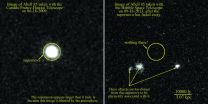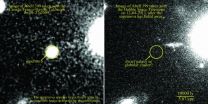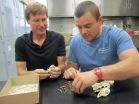(Press-News.org) Sharp images obtained by the Hubble Space Telescope confirm that three supernovae discovered several years ago exploded in the dark emptiness of intergalactic space, having been flung from their home galaxies millions or billions of years earlier.
Most supernovae are found inside galaxies containing hundreds of billions of stars, one of which might explode per century per galaxy.
These lonely supernovae, however, were found between galaxies in three large clusters of several thousand galaxies each. The stars' nearest neighbors were probably 300 light years away, nearly 100 times farther than our sun's nearest stellar neighbor, Proxima Centauri, 4.24 light years distant.
Such rare solitary supernovae provide an important clue to what exists in the vast empty spaces between galaxies, and can help astronomers understand how galaxy clusters formed and evolved throughout the history of the universe.
The solitary worlds reminded study leader Melissa Graham, a University of California, Berkeley, postdoctoral fellow and avid sci-fi fan, of the fictional star Thrial, which, in the Iain Banks novel Against a Dark Background, lies a million light years from any other star. One of its inhabited planets, Golter, has a nearly starless night sky.
Any planets around these intracluster stars - all old and compact stars that exploded in what are called Type Ia supernovae - were no doubt obliterated by the explosions, but they, like Golter, would have had a night sky depleted of bright stars, Graham said. The density of intracluster stars is about one-millionth what we see from Earth.
"It would have been a fairly dark background indeed," she said, "populated only by the occasional faint and fuzzy blobs of the nearest and brightest cluster galaxies."
Graham and her colleagues - David Sand of Texas Tech University in Lubbock, Dennis Zaritsky of the University of Arizona in Tucson and Chris Pritchet of the University of Victoria in British Columbia - will report their analysis of the three stars in a paper to be presented Friday, June 5, at a conference on supernovae at North Carolina State University in Raleigh. Their paper has also been accepted by the Astrophysical Journal.
Clusters of thousands of galaxies
The new study confirms the discovery between 2008 and 2010 of three apparently hostless supernovae by the Multi-Epoch Nearby Cluster Survey using the Canada-France-Hawaii Telescope on Mauna Kea in Hawaii. The CFHT was unable to rule out a faint galaxy hosting these supernovae. But the sensitivity and resolution of images from the Hubble Space Telescope's Advanced Camera for Surveys are 10 times better and clearly show that the supernovae exploded in empty space, far from any galaxy. They thus belong to a population of solitary stars that exist in most if not all clusters of galaxies, Graham said
While stars and supernovae typically reside in galaxies, galaxies situated in massive clusters experience gravitational forces that wrench away about 15 percent of the stars, according to a recent survey. The clusters have so much mass, though, that the displaced stars remain gravitationally bound within the sparsely populated intracluster regions.
Once dispersed, these lonely stars are too faint to be seen individually unless they explode as supernovae. Graham and her colleagues are searching for bright supernovae in intracluster space as tracers to determine the population of unseen stars. Such information provides clues about the formation and evolution of large scale structures in the universe.
"We have provided the best evidence yet that intracluster stars truly do explode as Type Ia supernovae," Graham said, "and confirmed that hostless supernovae can be used to trace the population of intracluster stars, which is important for extending this technique to more distant clusters."
Graham and her colleagues also found that a fourth exploding star discovered by CFHT appears to be inside a red, round region that could be a small galaxy or a globular cluster. If the supernova is in fact part of a globular cluster, it marks the first time a supernova has been confirmed to explode inside these small, dense clusters of fewer than a million stars. All four supernovae were in galaxy clusters sitting about a billion light years from Earth.
"Since there are far fewer stars in globular clusters, only a small fraction of the supernovae are expected to occur in globular clusters," Graham said. "This might be the first confirmed case, and may indicate that the fraction of stars that explode as supernovae is higher in either low-mass galaxies or globular clusters."
Graham said that most theoretical models for Type Ia supernovae involve a binary star system, so the exploding stars would have had a companion throughout their lifetimes.
"This is no love story, though," she added. "The companion was either a lower-mass white dwarf that eventually got too close and was tragically fragmented into a ring that was cannibalized by the primary star, or a regular star from which the primary white dwarf star stole sips of gas from its outer layers. Either way, this transfer of material caused the primary to become unstably massive and explode as a Type Ia supernova."
INFORMATION:
Graham's postdoctoral fellowship is supported by gifts from Gary and Cynthia Bengier.
AURORA, Colo. June 3 -- As America's obesity epidemic continues to grow, a new study from the University of Colorado Anschutz Medical Campus shows that a low-cost, non-profit weight loss program offers the kind of long-term results that often elude dieters.
'We know that people lose weight and then gain it back,' said study author Nia S. Mitchell, M.D., MPH, a researcher with the Division of General Internal Medicine at the Anschutz Health and Wellness Center at CU Anschutz. 'In this case, we found that people who renewed their annual membership in the program lost a ...
One of the most widely used tools in epigenetics research - the study of how DNA packaging affects gene expression - is chromatin immunoprecipitation (ChIP), a technique that allows researchers to examine interactions between specific proteins and genomic regions. However, ChIP is a relative measurement, and has significant limitations that can lead to errors, poor reproducibility and an inability to be compared between experiments.
To address these issues, scientists from the University of Chicago have developed a new technique that calibrates ChIP experiments with an ...
About one-third of patients admitted to an intensive care unit (ICU) will develop delirium, a condition that lengthens hospital stays and substantially increases one's risk of dying in the hospital, according to a new study led by Johns Hopkins Medicine researchers appearing in the British Medical Journal.
"Every patient who develops delirium will on average remain in the hospital at least one day longer," says one of the study's authors, Robert Stevens, M.D., a specialist in critical care and an associate professor at the Johns Hopkins University School of Medicine. ...
[EMBARGOED UNTIL THURSDAY, JUNE 4] Although treatment advances have dramatically reduced deaths from opportunistic infections related to AIDS, a new study drawing on 30 years of data from more than 20,000 patients in San Francisco suggests there is still ample room to improve. About a third--35 percent--of AIDS patients diagnosed with their first opportunistic infection from 1997 to 2012 in that city died within five years, according to the study, published in the Journal of Infectious Diseases.
"While recent research suggests that many opportunistic infections in the ...
Philadelphia, PA, June 4, 2015 - Children with Autism Spectrum Disorder (ASD) are often picky eaters, which can lead parents to suspect that their children might not be getting adequate amounts of vitamins and minerals. This sometimes leads parents of children with ASD to try nutritional supplements and dietary regimens such as gluten-free and casein-free (GFCF) diets without professional supervision. In the largest study of its kind, published in the Journal of the Academy of Nutrition and Dietetics, researchers report that these well-intentioned efforts can result in ...
In a new study, scientists have gathered all available NASA/ESA Hubble Space Telescope data on the four outer moons of Pluto to analyse the system in more depth than ever before. The observations show that at least two of Pluto's moons are not neatly rotating on their axes but are in chaotic rotation while orbiting around Pluto and its companion Charon. The study also hints that one of the moons has a mysterious jet-black colouring. These surprising results appear in the 4 June issue of the journal Nature.
Almost every moon in the Solar System, including our moon, rotates ...
SALT LAKE CITY, June 4, 2015 - At times during the past 10,000 years, cottontails and hares reproduced like rabbits and their numbers surged when the El Niño weather pattern drenched the Pacific Coast with rain, according to a University of Utah analysis of 3,463 bunny bones.
The study of ancient rabbit populations at a Baja California site may help scientists better understand how mammals that range from the coast to the interior will respond to climate change, says anthropology doctoral student Isaac Hart. He is first author of the study to be published in the ...
A rare and elusive rabbit has been found, held and photographed by a researcher from the University of East Anglia (UEA).
The Annamite Striped rabbit, found in the forests of Laos and Vietnam, was first documented by rabbit expert Dr Diana Bell and colleagues from UEA's School of Biological Sciences in the journal Nature in 1999. It has rarely been seen since.
Researcher Sarah Woodfin, who is studying for a Masters in Applied Ecology and Conservation at UEA, set out on a three-month expedition to track the recently-discovered rabbit and study its habitat.
But she ...
Many aquatic species have a reputation for negligent parenting. Having cast their gametes to the currents, they abandon their offspring to their fate. However, hands-on parenting is taken to a whole new dimension in the Syngnathidae fish family. Instead of leaving the responsibility to the females, seahorse and pipefish males take the pledge to care for their young even before the eggs are fertilized. The females depart soon after placing their eggs directly into the male's brood pouch, leaving the soon-to-be fathers to incubate the developing embryos. Ines Braga Goncalves ...
Cancer has overtaken cardiovascular disease, which includes heart disease and stroke, as the UK's No 1 killer--but only among men, reveals research published online in the journal Heart.
Cardiovascular disease is still the most common cause of death among women, and kills more young women than breast cancer, the figures show.
The researchers used the latest nationally available data (2012-13) for each of the four UK countries and the Cardiovascular Disease Statistics 2014 report compiled for the British Heart Foundation (BHF) to quantify the prevalence of cardiovascular ...




